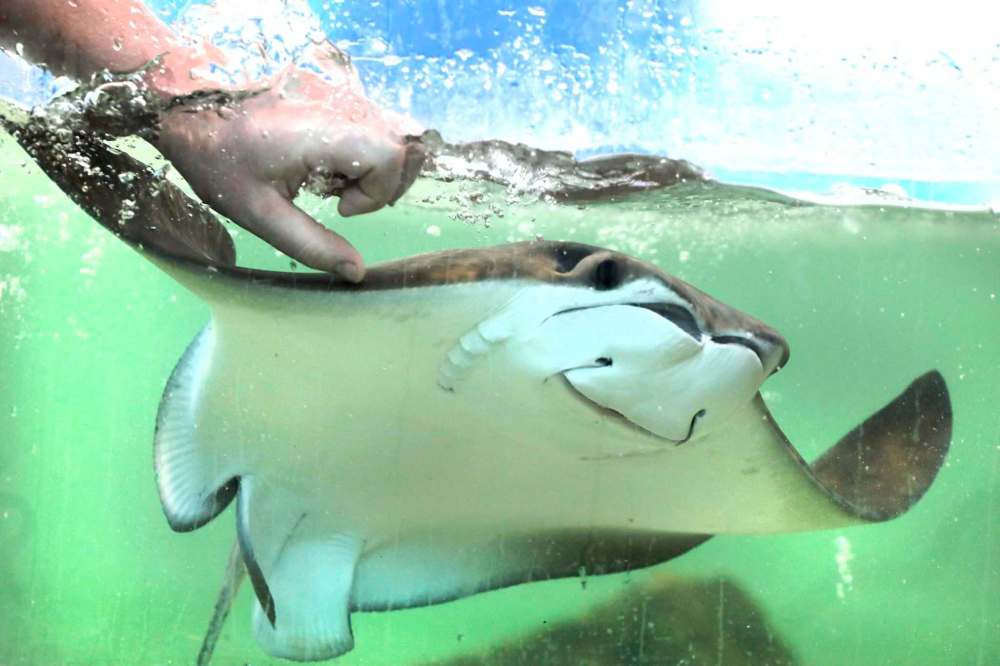Stingrays on display out of touch
Advertisement
Read this article for free:
or
Already have an account? Log in here »
To continue reading, please subscribe:
Monthly Digital Subscription
$1 per week for 24 weeks*
- Enjoy unlimited reading on winnipegfreepress.com
- Read the E-Edition, our digital replica newspaper
- Access News Break, our award-winning app
- Play interactive puzzles
*Billed as $4.00 plus GST every four weeks. After 24 weeks, price increases to the regular rate of $19.00 plus GST every four weeks. Offer available to new and qualified returning subscribers only. Cancel any time.
Monthly Digital Subscription
$4.75/week*
- Enjoy unlimited reading on winnipegfreepress.com
- Read the E-Edition, our digital replica newspaper
- Access News Break, our award-winning app
- Play interactive puzzles
*Billed as $19 plus GST every four weeks. Cancel any time.
To continue reading, please subscribe:
Add Winnipeg Free Press access to your Brandon Sun subscription for only
$1 for the first 4 weeks*
*$1 will be added to your next bill. After your 4 weeks access is complete your rate will increase by $0.00 a X percent off the regular rate.
Read unlimited articles for free today:
or
Already have an account? Log in here »
Hey there, time traveller!
This article was published 05/07/2019 (2281 days ago), so information in it may no longer be current.
A stingray swims along the bottom of a shallow tank. Hand after hand juts into the water to touch, fondle, prod. The ray has nowhere to hide, nowhere to escape, but can only keep swimming, round and round, enduring the forced interactions day after day. And for what? To entertain humans — children, mainly — for the price of admission at Winnipeg’s Assiniboine Park Zoo.
It’s hard to imagine how, in this day and age, anyone ever thought this was a good idea.
After a temporarily closure, following three stingrays dying and another three being injured, reportedly due to aggressive mating behaviour (something zoo reps have deemed “natural,” yet appear to have been unprepared for) the exhibit reopened this past Tuesday. The re-opening comes despite calls from animal activists (including myself), along with the Winnipeg Humane Society, to keep the exhibit closed for good. And for good reason: stingray touch pools are unethical and unnecessary. This type of exhibit is not new. Nor are the controversies surrounding them. In 2008, 41 stingrays died at the Calgary Zoo, reportedly due to lack of oxygen in their tank. The exhibit closed for good a few months (and few more deaths) later. Toronto’s Ripley Aquarium came under fire in 2014 after more than 30,000 people signed a petition calling for its touch pool to be closed.

The following year, 51 stingrays died at a zoo in Chicago, reportedly due to a technical malfunction with the pool’s oxygen pump. Another 18 rays died at a zoo in Michigan in 2016, due to a similar malfunction. The Assiniboine Park Zoo says at least a quarter of the world’s ray species are threatened with extinction. “A number of zoos have experienced major problems with stingray touch tank exhibits, including injuries to the animals and mass die-offs,” echoes Rob Laidlaw, executive director of Zoocheck, a Canadian wildlife protection charity. “Stingray touch tanks often feature animals who are sourced from the wild and kept in small, unnaturally shallow pools to facilitate contact by visitors.
“Many animals in these kinds of displays may be inappropriately handled by members of the public and opportunities for the animals to move away from contact and the stress associated with it may be minimal.” Laidlaw adds that the stingrays are typically altered via the removal of the barb attached to their tails.
Regarding zoos in general, animal rights lawyer Camille Labchuk of Animal Justice adds, “For visitors, zoos offer an afternoon of entertainment. For the animals imprisoned there, zoos are a life sentence — or a death sentence, in the heartbreaking case of the Winnipeg stingrays.” She says when animals like stingrays are kept in small tanks and harassed by zoo visitors, “their routines, habits, and natural social groupings are completely disrupted, inevitably leading to foreseeable deaths and injuries.”
Zoos will often claim that captive stingrays somehow find pleasure in this type of interaction with humans. In a blog post Wednesday, however, the WHS states, “Contrary to what we have heard in the media, there is no evidence that these creatures enjoy large-scale human interaction. Nor do they like being confined to very small pools.”
Whether or not you are someone who believes these animals enjoy the constant manhandling feature of touch pools (and many do believe that), the ethics are far less subjective.
What are we teaching children? That animals are playthings. That animals belong in captivity, are not worthy of choice, and that we are only able to learn about them via entertainment and exploitation. I thought we were getting over the circus? “The continued exploitation of stingrays in this fashion is reminiscent of the old zoo days,” Laidlaw astutely remarks, “when animal shows and encounters were routinely brought in because zoos felt they needed attractions to compete with other kinds of entertainment businesses.” As Canada moves forward in our evolution of thought regarding animals — most recently banning whale and dolphin captivity, and the importation of shark fin — the Assiniboine Park Zoo’s recent opening, and subsequent reopening, of a stingray touch pool simply shows that Winnipeg is out of touch. We can do better. Jessica Scott-Reid is a Winnipeg-based writer and animal/environmental advocate.
History
Updated on Friday, July 5, 2019 7:46 AM CDT: Fixes headline
Updated on Friday, July 5, 2019 9:12 AM CDT: Corrects typo



